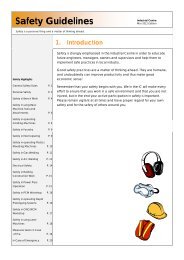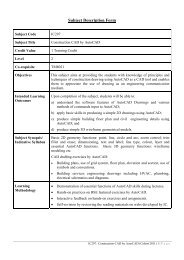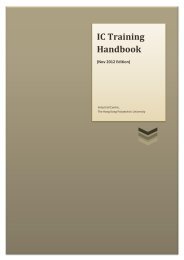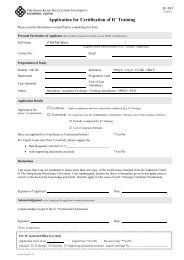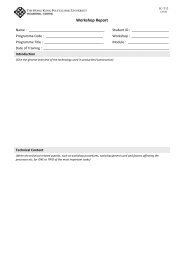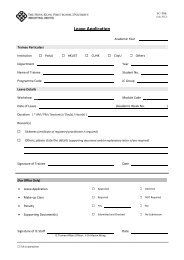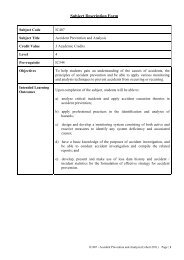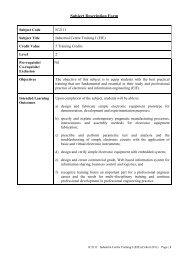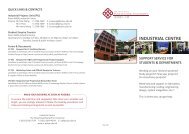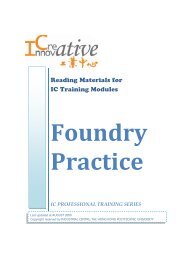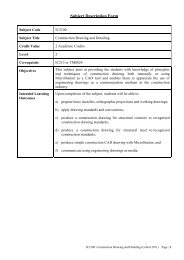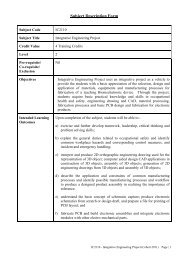IC347 - Construction Safety
IC347 - Construction Safety
IC347 - Construction Safety
Create successful ePaper yourself
Turn your PDF publications into a flip-book with our unique Google optimized e-Paper software.
Subject Code <strong>IC347</strong><br />
Subject Title <strong>Construction</strong> <strong>Safety</strong><br />
Credit Value 3 Academic Credits<br />
Level 3<br />
Pre-requisite CSE376 or IC344<br />
Co-requisite CSE375<br />
Objectives<br />
Intended Learning<br />
Outcomes<br />
Subject Description Form<br />
To help students understand the principles of local legislation concerning<br />
construction safety and gain skills in hazards identification and knowledge<br />
about standards of international good practices for control of risks in the<br />
construction process.<br />
Upon completion of the subject, students will be able to:<br />
Category A Professional/academic knowledge and skills<br />
a) demonstrate a basic knowledge of the typical construction site<br />
organisation, key construction processes and the critical issues affecting<br />
construction safety in Hong Kong;<br />
b) identify and assess safety and health hazards common in construction<br />
sites and to recommend control measures with respect to legal<br />
requirements, reasonable and practical practice and cost consideration;<br />
c) provide professional judgement and knowledge on safety and health in<br />
assisting the site management in the development of method statement<br />
of construction processes; and<br />
d) identify key factors contributing to safety and health in construction<br />
industry in view of the sub-contracting systems, rapid changing site<br />
conditions, complexity nature of work and legal requirements.<br />
Category B Attributes for all-roundedness<br />
a) identify local and international trends in safety management in<br />
construction industry; and<br />
b) identify social and economic implications of safety and health issues in<br />
construction industry.<br />
<strong>IC347</strong> - <strong>Construction</strong> <strong>Safety</strong> (Cohort 2011) Page | 1
Subject Synopsis/<br />
Indicative Syllabus<br />
1) Introduction<br />
Overview of the structure of construction industry in Hong Kong.<br />
Review of safety performance in Hong Kong’s construction industry.<br />
Introduction of occupational safety and related construction safety<br />
legislation. Factors affecting accident rates in construction industry.<br />
<strong>Construction</strong> site layout and organization. General hazards of<br />
construction.<br />
2) Working at height; Scaffolds and Falsework<br />
Common types of scaffolds, working platforms and falsework used in<br />
construction sites. Main hazards associated with works on scaffolds,<br />
working platform and falsework. <strong>Safety</strong> considerations in design,<br />
construction and maintenance of scaffolds and falsework. Associated<br />
statutory regulations. (Assignment: case study report on collapse of<br />
metal scaffolding)<br />
3) Cranes, Hoists and Builder’s Lift<br />
Common types of cranes, hoists and builder’s lift used in construction<br />
activities. Main hazards associated with operation of cranes and hoists.<br />
Safe use of cranes, hoists and builder’s lift. Associated statutory<br />
regulations.<br />
4) Transport and Mobile Plants<br />
Types of transports and mobile plants used in construction site. Main<br />
hazards associated with transports and mobile plants. Site transport<br />
planning. Associated statutory regulations.<br />
5) Earthwork and Excavation and Tunneling<br />
Introduction of soil types and earthwork in Hong Kong. Main hazards<br />
associated with excavation and slope work. <strong>Safety</strong> precautions and earth<br />
supporting systems in excavation. Principal hazards in slope and<br />
tunneling work. Associated statutory regulations. (Assignment: case<br />
study report on safety in deep excavation)<br />
6) Demolition and Dismantling<br />
Demolition method statement planning. Pre-survey inspection of the<br />
structure to be demolished. Methods of demolition. Main hazards<br />
associated with demolition and dismantling.<br />
7) Occupational Health Hazards<br />
Common types of occupational health hazards in construction industry<br />
in Hong Kong: chemical, physical and biological; associated statutory<br />
regulations.<br />
8) <strong>Construction</strong> <strong>Safety</strong> Management<br />
Review of the industrial safety management strategy of the Government<br />
of HKSAR. Legal and contractual requirements on safety in local<br />
construction projects. <strong>Safety</strong> management systems of local contractors.<br />
Training for different vocational groups in construction. Trends of<br />
construction safety management in mainland China and developed<br />
countries.<br />
<strong>IC347</strong> - <strong>Construction</strong> <strong>Safety</strong> (Cohort 2011) Page | 2
Learning<br />
Methodology<br />
Assessment<br />
Methods in<br />
Alignment with<br />
Intended Learning<br />
Outcomes<br />
Student Study<br />
Effort Required<br />
Students will be required to relate the lectured materials with real problems.<br />
Through case studies and exercises, students will analyze the causes of<br />
accidents, carry out job hazard analysis and risk assessment, and develop<br />
method statements for construction activities. Students will work in groups<br />
and share their observation through interactive discussions. Site visit will be<br />
arranged to appreciate the real construction processes, site safety practices.<br />
Assessment Methods<br />
Weighting<br />
(%)<br />
Intended Learning<br />
Outcomes Assessed<br />
a b c d<br />
1. Coursework 40 <br />
2. Examination 60 <br />
Total 100<br />
Wide range of real construction projects and accident cases are used in the<br />
assignments which test the student’s general knowledge in hazard<br />
identification and application of regulations in construction safety. The<br />
coverage of the questions in the examination will embrace most of the<br />
syllabus and be set to align with all the intended learning outcomes.<br />
Class Contact<br />
Lecture 28 Hrs.<br />
Tutorial 14 Hrs.<br />
Other Study Effort<br />
Coursework 36 Hrs.<br />
Total Study Effort 78 Hrs.<br />
<strong>IC347</strong> - <strong>Construction</strong> <strong>Safety</strong> (Cohort 2011) Page | 3
Reading List and<br />
References<br />
Essential Textbook:<br />
Davies V. J. and Tomasin, K. (1996). <strong>Construction</strong> <strong>Safety</strong> Handbook.<br />
London: Thomas Telford.<br />
Reference Textbooks:<br />
1. Lingard, H. and Rowlinson, S. (2005). Occupational Health & <strong>Safety</strong> in<br />
<strong>Construction</strong> Project Management. London: Spon Press.<br />
2. Rowlinson, S. M. (2003). Hong Kong <strong>Construction</strong>: Site <strong>Safety</strong><br />
Management and the Law. (2 nd Edition). Hong Kong: Sweet & Maxwell<br />
Asia.<br />
3. Lee, H. K. (1996). <strong>Construction</strong> <strong>Safety</strong> in Hong Kong. Hong Kong:<br />
Lorrainelo Concept.<br />
<strong>IC347</strong> - <strong>Construction</strong> <strong>Safety</strong> (Cohort 2011) Page | 4



